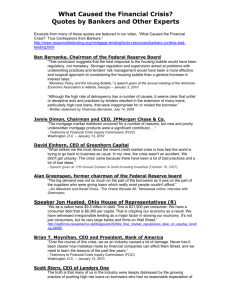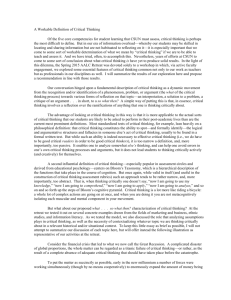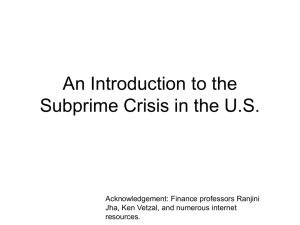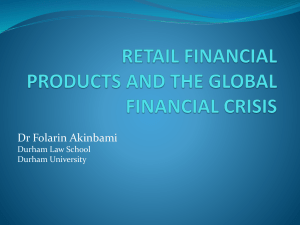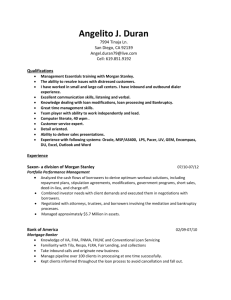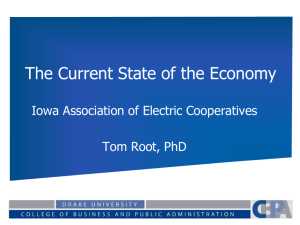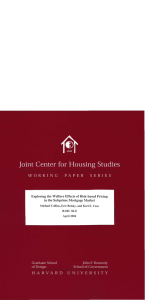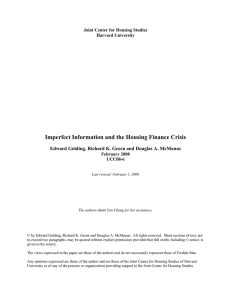Subprime mortgage crisis
advertisement
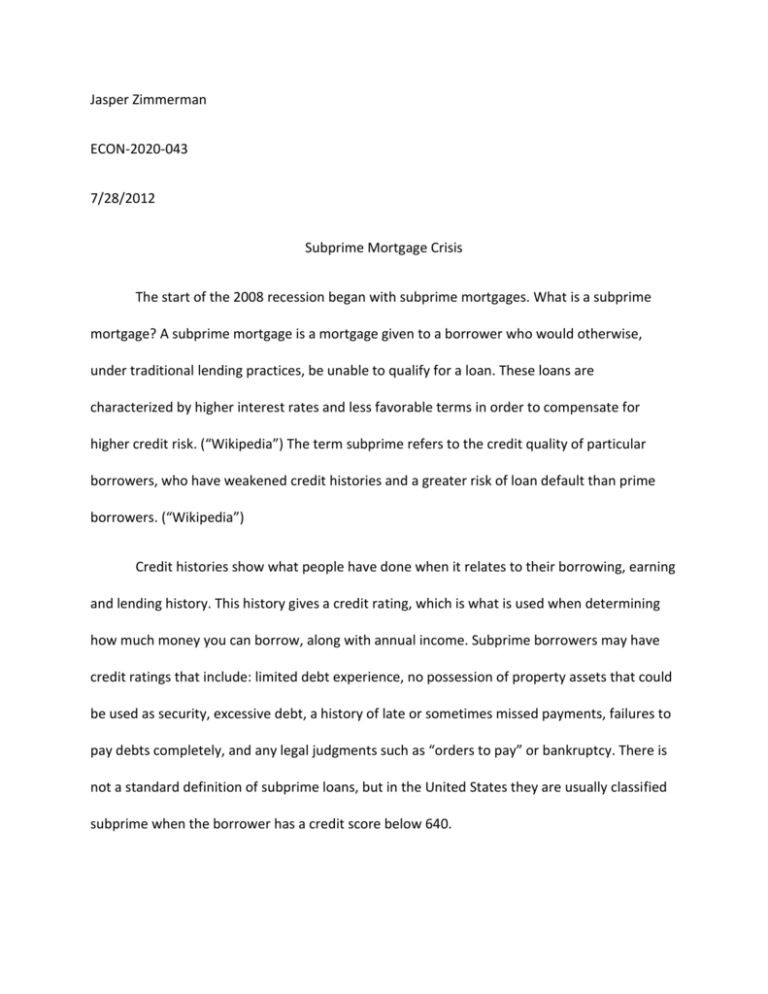
Jasper Zimmerman ECON-2020-043 7/28/2012 Subprime Mortgage Crisis The start of the 2008 recession began with subprime mortgages. What is a subprime mortgage? A subprime mortgage is a mortgage given to a borrower who would otherwise, under traditional lending practices, be unable to qualify for a loan. These loans are characterized by higher interest rates and less favorable terms in order to compensate for higher credit risk. (“Wikipedia”) The term subprime refers to the credit quality of particular borrowers, who have weakened credit histories and a greater risk of loan default than prime borrowers. (“Wikipedia”) Credit histories show what people have done when it relates to their borrowing, earning and lending history. This history gives a credit rating, which is what is used when determining how much money you can borrow, along with annual income. Subprime borrowers may have credit ratings that include: limited debt experience, no possession of property assets that could be used as security, excessive debt, a history of late or sometimes missed payments, failures to pay debts completely, and any legal judgments such as “orders to pay” or bankruptcy. There is not a standard definition of subprime loans, but in the United States they are usually classified subprime when the borrower has a credit score below 640. The subprime mortgage crisis goes all the way back to 2001. In 2001 we already had a struggling economy that became worse with fear of global terror attacks. In response, during 2001, the Federal Reserve began cutting rates dramatically, and the fed funds rate arrived at 1% in 2003, which in central banking parlance is essentially zero. (Barnes) The reason for lowering the rate so much was to increase spending and borrowing, to help the economy recover. With interest rates being so low people began to buy real estate in increasing numbers. With more houses being sold the prices of houses increased as well. The next step in creating the subprime mortgage crisis was the asset-backed security. Asset-backed security (ABS) has been around for decades, and at its core lies a simple investment principle: Take a bunch of assets that have predictable and similar cash flows (like an individual's home mortgage), bundle them into one managed package that collects all of the individual payments (the mortgage payments), and use the money to pay investors a coupon on the managed package.(Barnes) These securities were bundled together with prime borrowers and subprime borrowers, but were still given “A+” ratings that signaled their relative safety as an investment. Asset-backed securities had been sold for years with these “A+” ratings, and always had government backing which increased the security of buying them. The real estate market was booming and more and more families were buying homes when they had never been able to before. A big reason why so many people were able to get loans, that they previously would not have been able to do, was due to ARM’s. Adjustable-rate mortgages are as they sound, adjustable. The interest rate that the borrower pays is usually set for two years and then resets periodically. Another risky loan that entered the picture was the interest-only loan. This loan allows for borrowers to pay the interest only for a number of years. That was fine until the interest rate kicker raised monthly payments up substantially. (Amadeo) The thought behind these loans was to refinance before the payments increased, or simply sell the home and get another mortgage. Borrowers didn’t take into account in the booming housing market that any decrease in home value would leave the borrower with an untenable combination of a balloon payment and a much higher mortgage payment. (Barnes) As the real estate market continued to grow mortgage lenders became laxer in their lending practices. They began to overlook basic requirements like proof of income and a down payment. Lenders even began giving out loans that were more than what the home value was, because with rising prices the home would be above water in less than two years. Record-low interest rates had combined with ever-loosening lending standards to push real estate prices to record highs across most of the United States. (Barnes) Homeowners were refinancing in record numbers, taking recently earned equity out of their home, and gaining a larger mortgage. Over the space of five years home prices had doubled, and interest rates had stayed at all time lows. In the middle of 2006, however, we began to see problems. Home sales stalled, interest rates were on the rise, and inflation was a fear. Adjustable rate mortgages began to reset with higher interest rates, and borrowers began to default on their loans. As word spread about loans defaulting the lending practices began to tighten, but the damage was done and it was too late to go back. There had been too many loans made to borrowers that should not have gotten loans in the first place. It is nice to think that everyone can be a home owner, and it is true, but it can’t just be given. A borrower needs to be able to show that they deserve a loan and that they can pay it back. With home prices increasing as much as they did, refinancing put millions of people underwater on their homes once the prices began to fall. Interest-only loans began to increase in the size of payment, and borrowers could no longer refinance because their loan was more than the home was worth. These balloon payments made many people default on their loan because they simply could not afford to pay their mortgage. The asset-backed securities that had been such a good investment idea had now become a big problem. With so many loans going into default these securities were no longer paying the returns promised. These securities that were owned by lenders were decreasing in value substantially. The owners began to foreclose on homes after a few missed payments, so that the homes could be resold to gain some money coming in. In the end there are several things that came together to make the subprime mortgage crisis as bad as it was. It all started, however, by lending to those people who could not afford a traditional loan so the lenders got creative with their lending practices. Once one lender started this practice it spread like wildfire because other lenders saw the possible gain. With raising home prices and extremely loan interest rates what could go wrong? The thing to remember for the future so we don’t have another crisis of this magnitude, is to lend to those who can truly afford it, and what goes up must come down. "Subprime lending." Wikipedia. N.p., June 2, 2012. Web. 28 Jul 2012. <http://en.wikipedia.org/wiki/Subprime_lending>. Barnes, Ryan. "The Fuel That Fed The Subprime Meltdown ." Investopedia. N.p., September 04 2007. Web. 28 Jul 2012 http://www.investopedia.com/articles/07/subprime-overview.asp#axzz21xE730RR Amadeo, Kimberly. "Understanding the Subprime Mortgage Crisis." About.com. N.p., March 20,2012. Web. 29 Jul 2012. <http://useconomy.about.com/od/economicindicators/tp/Subprime-MortgagePrimer.htm>.
